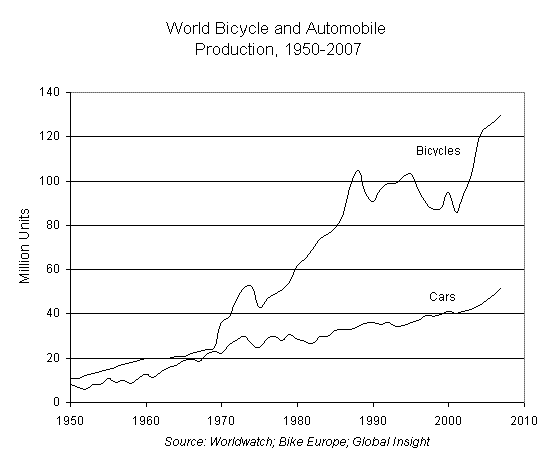The Earth Policy Institute Releases a Report on the Rise of Bikes
 Rick Ridgeway tipped us to the following article from the Earth Policy Institute. It’s part of their Eco-Economy Indicators research — twelve trends that the Institute tracks to measure progress towards building an eco-economy.
Rick Ridgeway tipped us to the following article from the Earth Policy Institute. It’s part of their Eco-Economy Indicators research — twelve trends that the Institute tracks to measure progress towards building an eco-economy.
Bicycles Pedaling Into the Spotlight
J. Matthew Roney
The world produced an estimated 130 million bicycles in 2007—more than twice the 52 million cars produced. Bicycle and car production tracked each other closely in the mid-to-late 1960s, but bike output separated sharply from that of cars in 1970, beginning its steep climb to 105 million in 1988. Following a slowdown between 1989 and 2001, bike production has regained steam, increasing in each of the last six years. Much of the recent growth has been driven by the rise in electric, or “e-bike” production, which has doubled since 2004 to 21 million units in 2007. Overall, since 1970, bicycle output has nearly quadrupled, while car production has roughly doubled.
Promoting the bike as a clean and efficient alternative to the personal automobile is a practical way for cities to reduce traffic congestion and smog. To simultaneously confront those problems as well as climate change and an emerging obesity epidemic, government leaders and advocacy groups are working to bring cycling back to prominence in the urban transport mix.
A number of European cities have set the standard for bicycle use andpromotion, via pro-bike transportation and land use policies, as wellas heavy funding for bicycle infrastructure and public education. InCopenhagen, for example, 36 percent of commuters bike to work. The cityplans to invest more than $200 million in bike facilities between 2006and 2024 and estimates that by 2015 half its residents will bike towork or school. In Amsterdam, cycling accounts for 55 percent ofjourneys to jobs that are less than 7.5 kilometers (4.7 miles) fromhome. The government has pledged to spend $160 million from 2006 to2010 on bicycle paths, parking, and safety. And Freiburg, Germany, acity with 218,000 people, has allocated roughly $1.3 million annuallyfor cycling since 1976; now some 70 percent of local trips there aremade by bike, on foot, or by public transit.
Governments elsewhere are following Europe’s lead. Bogotá, Colombia,boasts more than 300 kilometers of bikeways, the most for a city in thedeveloping world. In Australia, the state of Victoria has amendedplanning laws to require all new large buildings to provide bikeparking and other facilities such as showers and lockers. And inNovember 2007, South Korea’s Home Affairs Ministry announced a newpro-bike campaign to alleviate increasing traffic and air pollution andto cope with soaring oil prices. As it expands bicycle infrastructure,the government aims to substantially increase bike ownership by 2015,from one bike for every seven citizens to one for every four.
Some notoriously polluted and congested cities are working to reap thebenefits of cycling as well. Mexico City plans to have 5 percent of alltrips be by bike in 2012, up from less than 2 percent today, usingtraffic calming methods, promotional campaigns, and bike-transitconnectivity. In India, Delhi’s newest Master Plan requires fullysegregated bicycle tracks on all arterial roads and notes thatpromoting cycling will be an essential component of the city’s plans toreduce growth in fossil fuel consumption. (See additional examples ofbicycle promotion initiatives.)
Bicycle rental programs are also increasing bike use in some cities.The stand-out example of 2007 was Paris’s low-cost Vélib rental scheme,launched in July. Now offering 20,600 bikes that can be obtained bycredit card at 1,451 stations, the program logged 6 million rides inits first three months. Analysts expect the program to double or eventriple bike trips in Paris. Similar programs exist in Oslo, Barcelona,and Brussels and are planned for Washington, D.C., and central London,among other cities.
While biking remains popular for recreation in the United States, it iswoefully underused for transportation. Total cycling participation hasdeclined nationally since 1960, dropping 32 percent since the early1990s, and now accounts for just 0.9 percent of all trips. Cycling towork is even less frequent, at 0.4 percent of trips.
Despite these unimpressive statistics, encouraging signs can be seenfor the future of cycling in the United States. Aided by $900 million ayear in federal funding for promotion of biking and walking for 2005 to2009, the installation of bicycle facilities—including parking,bike-friendly roads, and designated lanes—is proceeding at a recordpace. Indeed, plans in the 50 largest U.S. cities would, on average,double their bicycle and pedestrian routes; New York City alone willquadruple its bike network to 2,900 kilometers by 2030.
Bicycle advocacy in the United States continues to grow as well. TheLeague of American Bicyclists now honors 84 U.S. towns and cities asBicycle Friendly Communities, compared with 52 in 2005. Cyclingadvocacy groups operate in 49 states and Washington, D.C. Perhaps mostexciting, a Complete Streets movement has blossomed in recent years, inwhich a broad coalition of citizen and environmental groups is callingfor safer, pedestrian- and cyclist-friendly roads designed foreveryone, not just cars. Six states and more than 50 cities, counties,and metro regions have now enacted some form of Complete Streetslegislation. For example, the Illinois General Assembly voted lastOctober to require all new state transportation construction projectsin and around urban areas to include bicycle and pedestrian ways.
While the bicycle is still an essential form of transportation inChina, the country has recently seen a rapid decrease in bike ownershipas its population becomes wealthier and turns to cars. From 1995 to2005, China’s bike fleet declined by 35 percent, from 670 million to435 million, while private car ownership more than doubled, from 4.2million to 8.9 million. Blaming cyclists for increasing accidents andcongestion, some city governments have closed bike lanes. Shanghai evenbanned bicycles from certain downtown roads in 2004. This deteriorationin Chinese bike culture emerges even as the country’s share of worldbicycle production continues to rise: China now turns out more thanfour fifths of the 130 million bikes produced each year.
China’s central government, increasingly concerned about trafficcongestion, energy consumption, and people’s health, has now beguncalling on cities to reverse this discouragement of bikes. In June2006, Deputy Minister of Construction Qiu Baoxing ordered cities thathad narrowed or removed bike lanes to restore them. Within Beijing,bike promotion is having some visible effects as the city prepares forthe 2008 Olympics. For example, after successful pilot projects, aprivate bike rental scheme co-sponsored by Beijing’s environmentalprotection and security bureaus aims to provide 50,000 bikes at some200 locations by August. Thus far, however, the recent pro-bicyclerhetoric from Beijing has not translated into much positive actionoutside the capital.
Development projects addressing disease and poverty in Africa provideevidence that the bicycle’s utility is not just limited to urban areas.In Zambia, World Bicycle Relief has partnered with a coalition ofrelief organizations to combat HIV/AIDS through more timely educationand treatment, providing 23,000 bicycles to healthcare volunteers,disease prevention educators, and families affected by the virus. InBurkina Faso, Ghana, and Uganda, an alliance of Dutch non-governmentalorganizations has launched a micro-credit lending program calledCycling Out of Poverty. Through this effort, poor people can pay offleased bikes while using them to attend school or start a smallbusiness.
With more than half the world’s population now living in cities, thereis tremendous potential for municipal governments and urban planners toincrease bicycle use by following classic European examples likeCopenhagen and Amsterdam. These cities have shown that by integratingbicycles in transportation planning, educating the public aboutcycling’s benefits, and discouraging driving with restrictions andtaxes on car ownership and parking, governments can greatly enhancebicycle use. This promotes people’s physical fitness while helping tocreate cleaner, more livable communities.
World Bicycle and Automobile Production, 1950-2007 (figure and table)
Selected Cycling-Promotion Initiatives from around the World, 2008 (table)
If you found this article interesting, check out the books offered by the Earth Policy Institute, including Lester Brown’s Eco-Economy: Building an Economy for the Earth.
[With thanks to Lester Brown and the Earth Policy Institute.]
